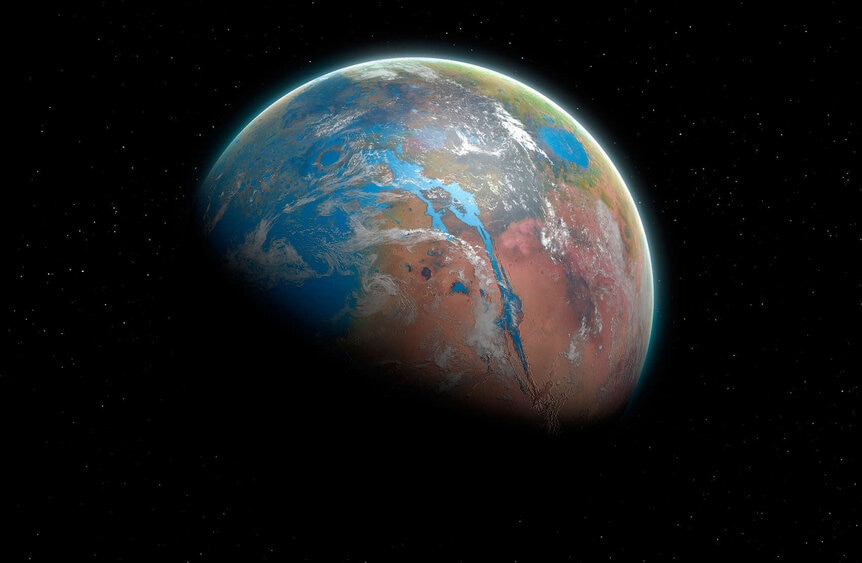Create a free profile to get unlimited access to exclusive videos, sweepstakes, and more!
Drying up a claim — maybe — of liquid water under the south pole of Mars
In 2018, planetary scientists made a startling announcement: They had found evidence for a large lake of liquid water under the south pole of Mars.
This was surprising for many reasons. For one, while we know there's a lot of frozen water on Mars — the polar ice caps are mostly water ice, and it's been seen just under the surface down to mid-latitudes — evidence of liquid water was scarce. Also, the south polar cap of Mars is cold, so this water would have to be extremely salty to withstand the brutal low temperature.
I was reasonably skeptical at the time (if I do say so myself; note the title of that article linked) but then they followed up in 2020 with more analysis showing the lake they found was indeed there (and relatively large at 20 x 30 kilometers in size), and that they found three more lakes! This seemed like it strengthened their hypothesis greatly.
However, a new study just published shows that while it's still possible there's liquid water under that great polar cap, it's by no means proven. They find that other materials, common on Mars, can also produce the results seen.
Looking for liquid water anywhere on Mars is a long-standing quest for scientists. We know Mars had liquid water on its surface in the past, because there's tons of evidence for it. Heck, the Perseverance rover was sent to land in Jezero crater because that impact feature used to be a vast standing lake! But that was eons ago, and since then Mars lost most of its atmosphere and dried up.
There's no standing water on its surface, and even the evidence for temporary water (like stuff leaking up from under the surface) is not conclusive. So finding huge lakes under the surface would be a Very Big Deal.
Both the earlier research and this new work was done using an instrument called the Mars Advanced Radar for Subsurface and Ionosphere Sounding which is on the ESA's Mars Express orbiter which has been at the Red Planet since late 2003. It pings the surface of Mars with radar and detects what bounces back to it. This can tell scientists a lot about the composition of the surface.
Radar also can pass through rock. If it hits something reflective below the surface it'll bounce back up to space and get picked up by the receiver. Analyzing the data from the south pole of Mars, the original team of scientists found a series of strong signals that they interpreted as liquid water under the surface.
The scientists doing the new research, though, wondered if maybe something else could produce that strong a signal. They point out that two different effects can create a strong reflection. One has to do with what's called dielectric permittivity. If you take a substance and put it in an electric field, the electrons and protons in the atoms of that material will try to align with the field (similar to how iron filings will align with the magnetic field of a magnet). Some substances react strongly and their atoms will align well, while others don't care as much and the electrons do what they want. The dielectric permittivity is the amount the charged particles align in the material.
If you have a substance, say a rock layer, with one value of this permittivity laying over a layer of some other substance, say water, with a different value, radar can be reflected strongly. That's the conclusion drawn in the first work, looking at the permittivity contrast between two layers of material.
In the new work, though, the second team looked at electric conductivity, how well material lets electricity flow through it. Different layers of material can have different conductivity, and that too can reflect radar strongly. They found that several materials can do this, including ones that are common on and under the Martian surface. For example, clays, metal-bearing minerals, and salty ice can also create conductivity contrast that would result in bright reflections.
Crucially, looking at the very same data the first team did, they find the bright reflections could be caused by these substances, and not necessarily liquid water. They stop short of saying the first team was wrong — the correct move, since the first team might be right. But it looks like the first results are now less likely. It's cold under the surface at the Martian austral pole, and you need special circumstances to have liquid water there: The water has to be incredibly briny. That's not impossible, but it's less likely than there just being layered deposits of clays or less briny water ice, which we know can exist.
We don't know who's right here (or if there's a third (or fourth or fifth…) possibility) and we might not for a while. Mars is pretty close by as the Universe goes, but it's still a long walk from Earth. We've learned a huge amount about it in the past few decades, but it's an entire world, with a vast surface and even more underneath. There will always be mysteries for us to solve, and sometimes that will include taking paths that don't play out, or play out differently than we expected. That's how science works, and that's how we learn.















